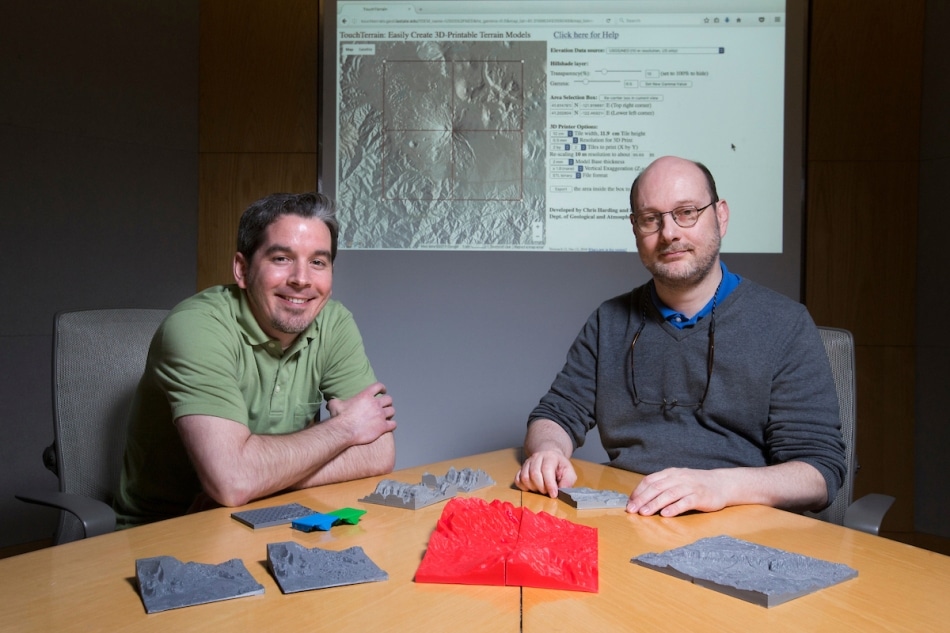Mar 14 2017
Today’s geology lesson is all about anticlines.
 Alex Renner, left, and Chris Harding, two of the developers of TouchTerrain, with the web application that makes it quick and easy to print 3-D terrain models.�Larger photo.�(Credit: Christopher Gannon.)
Alex Renner, left, and Chris Harding, two of the developers of TouchTerrain, with the web application that makes it quick and easy to print 3-D terrain models.�Larger photo.�(Credit: Christopher Gannon.)
Students can read all they want about geological folds, axial planes, hinge lines, antiformal synclines and synformal anticlines. But it can still be a challenge to visualize just what geologists are talking about.
A better option is putting boots on the ground – such as a trip to Iowa State University’s Carl F. Vondra Geology Field Station near Shell, Wyoming. The field station is in the north-central part of the state, on the western flank of the Bighorn Mountains. Nearby is Sheep Mountain, a well-known and typical anticline.
The Bighorn River has cut a canyon through the mountain and students can hike along the river to get a good look at a natural cross section of the exposed geological fold.
But most students aren’t able to make a trip to Sheep Mountain.
So Iowa State researchers have come up with a new option – TouchTerrain.
The web application is open source and free for private use through Iowa State’s GeoFabLab. It allows anybody with a 3-D printer to easily and quickly print terrain models of any place on the planet, including the ocean floor.
To demonstrate, Franek Hasiuk, an Iowa State assistant professor of geology and David Morehouse Faculty Fellow, placed four tiles of 3-D-printed plastic, each about 4 inches square, on the desk in front of him. Put them together, and there’s a scale model of Sheep Mountain and its central ridge rising out of the Bighorn Basin.
That’s a teaching tool that can help students see and touch an anticline – potentially a more powerful experience than studying a flat map or computer screen.
“This could be a key element in improving how geoscience students connect with the surface structure of the Earth,” said Chris Harding, an associate professor of geology and a member of Iowa State’s program in human computer interaction.
But, said Hasiuk, to be really useful, there had to be a fast, easy and reliable way for people to make the terrain models.
A technology challenge
It’s challenging to make 3-D terrain models that consistently print well on any commercial 3-D printer.
It requires an understanding of geographic information systems, computational geometry, design and manufacturing software and 3-D printing technology.
The TouchTerrrain development team includes Harding, with expertise in geographic information systems; Hasiuk, with expertise in 3-D printing of geological samples; Alex Renner, a doctoral student in mechanical engineering with expertise in simulations for 3-D printing; and Levi Baber, a College of Liberal Arts and Sciences information technology manager with expertise in server technology.
Even if a teacher had experience with geographic information systems, computer aided design software and 3-D printing, Harding said it can be a lengthy and complex process to generate a good digital terrain model that can be 3-D printed.
It’s an even bigger challenge to create models large enough for the classroom by making several tiles of, say, the Grand Canyon and seamlessly fitting them all together.
“Our application makes it very easy to create physically large models by dividing the desired area into multiple tiles that can then be 3-D printed separately and glued together to form a much larger 3-D map,” Harding said.
Models for everybody
Visit the TouchTerrain website and you see a terrain map with Wyoming’s Sheep Mountain inside a red box.
You can zoom in and out of that map, moving the red box anywhere in the world. When you settle on an area to print, you can adjust a few simple settings to match your 3-D printer, hit export and you’ll get a file for your 3-D printer. And, if you want, the terrain can be exaggerated to accentuate subtle details.
Adjusting the application’s digital models to a specific 3-D printer can be a big advantage for users.
“Why create a very large, high resolution model that takes a long time to process when a 3-D printer can only print out at a much lower resolution?” Harding said.
The cost of the resulting terrain models?
Operating a 3-D printer (now available for less than $2,000) costs about $1 per hour. Printing out a square, 4-inch terrain model typically costs about $2, Harding said.
The Iowa State researchers hope the ease and low cost of TouchTerrrain models will enable more geoscience teachers to use 3-D printed materials in their classes. The researchers’ next steps include enhancing the application’s capabilities and creating a way for teachers to connect specific locations with specific geologic concepts.
Hasiuk picked up a red plastic terrain model of north-central Iowa, a rolling landform known as the Des Moines Lobe. He said that model showed the effects of glacial activity and also represented one of the best things about TouchTerrain.
“You can’t buy this anywhere,” he said. “No one would ever make a terrain model of central Iowa, but this is very useful if you want to talk about your environment.”